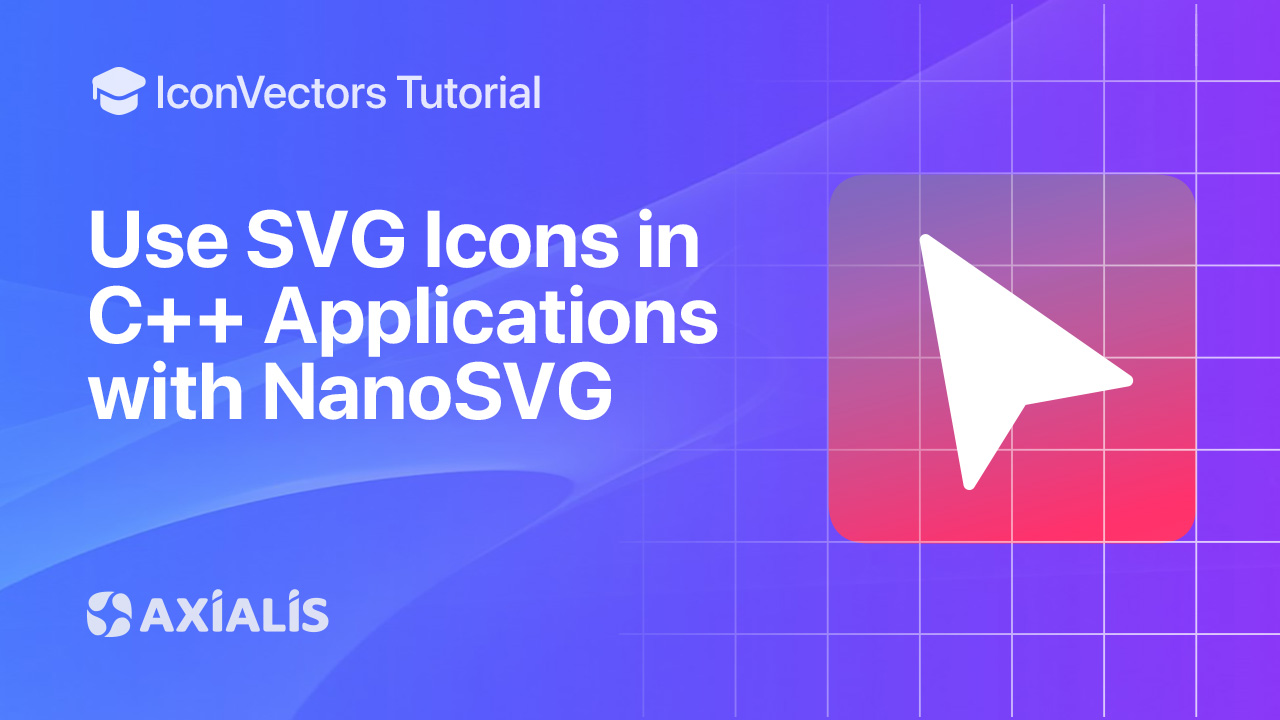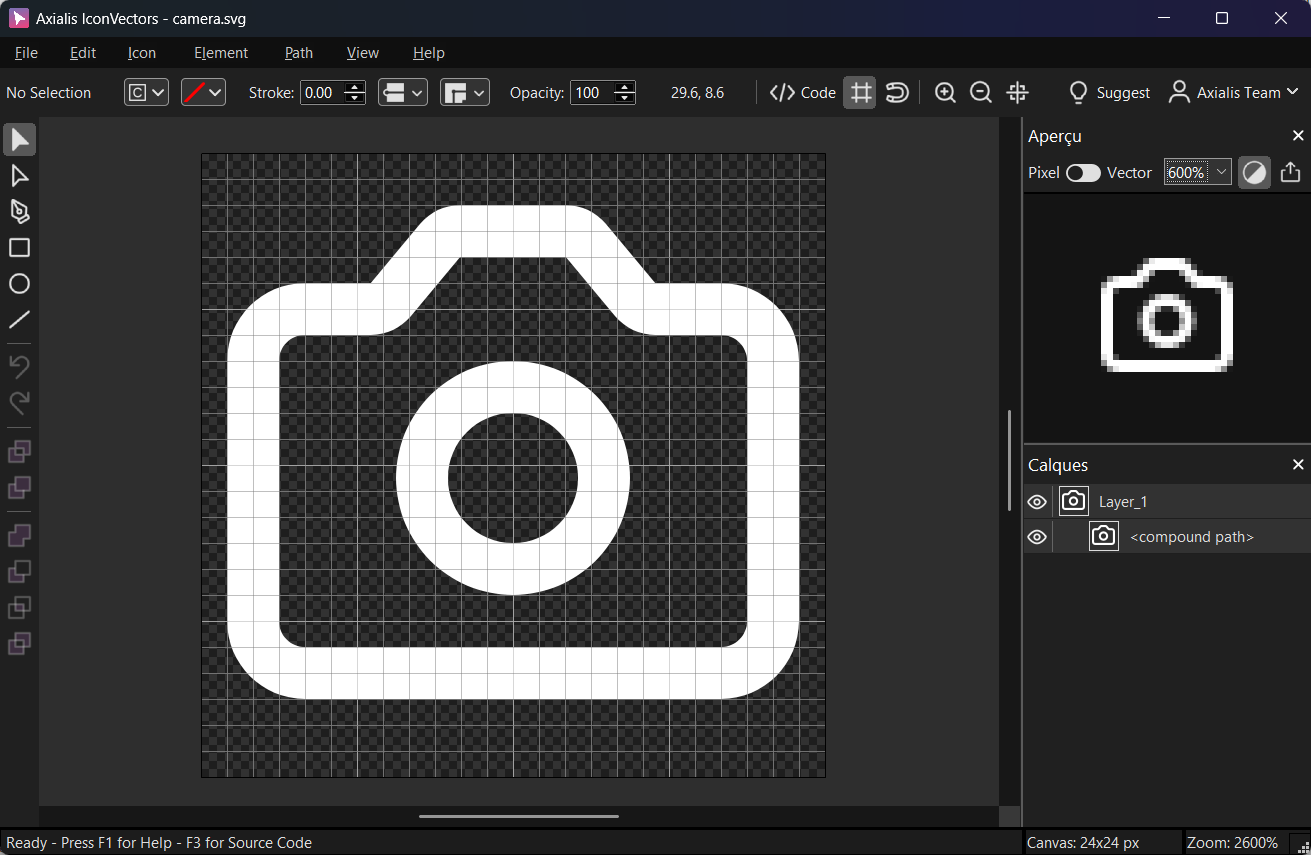Use SVG Icons in C++ Applications with NanoSVG

This guide shows how to import and render SVG icons in C++ using NanoSVG, starting from clean SVGs exported by Axialis IconVectors. You will: render to a Windows HBITMAP using the Windows API, export to PNG cross‑platform, and create a wxBitmap to draw in a wxWidgets app.
What is NanoSVG? Pros, cons, and setup
- Single‑header library — drop‑in C/C++ headers for parsing (
nanosvg.h) and rasterizing (nanosvgrast.h). - Fast path to pixels — parse an SVG to a lightweight
NSVGimage, then rasterize to an RGBA buffer. - Limitations — supports a practical subset of SVG (static icons and simple shapes); advanced filters/effects are out of scope. Great for icons/UI, not for full‑fidelity illustrations.
- Download — get NanoSVG from the official GitHub repository:
github.com/memononen/nanosvg.
Copy
src/nanosvg.handsrc/nanosvgrast.hinto your project, or add the repo as a Git submodule. - Install — copy the headers into your project and compile one translation unit with:
#define NANOSVG_IMPLEMENTATION #include "nanosvg.h" #define NANOSVGRAST_IMPLEMENTATION #include "nanosvgrast.h"
Export a clean SVG from IconVectors
- Open or create your icon:
- File → Open… (Ctrl+O) or New Icon (Ctrl+N).
- Prefer a simple, single‑color shape and a clean
viewBox(e.g.,0 0 24 24).

Use File → Export → Export Minified (Shift+Ctrl+M) to get a lean SVG.
Windows: render an SVG to HBITMAP using the Windows API (NanoSVG)
The snippet below parses SVG from memory, rasterizes with NanoSVG to straight‑alpha RGBA, then converts to a 32‑bpp top‑down DIB (HBITMAP) with BGRA premultiplied pixels for use with AlphaBlend.
#define NANOSVG_IMPLEMENTATION
#include "nanosvg.h" // SVG parser
#define NANOSVGRAST_IMPLEMENTATION
#include "nanosvgrast.h" // Rasterizer
#include <windows.h>
#include <cstdint>
#include <cstdlib>
#include <cstring>
#include <cmath>
#include <iostream>
static const char kSVG[] = R"SVG(
<svg xmlns="http://www.w3.org/2000/svg" viewBox="0 0 24 24"><path fill="none"
stroke="currentColor" stroke-width="2" stroke-linecap="round" stroke-linejoin="round"
stroke-miterlimit="10" d="M14.8 3.4l1.9 2.3c.2 .2 .5 .4 .8 .4H20c1.1 0 2 .9 2
2v10c0 1.1-.9 2-2 2H4c-1.1 0-2-.9-2-2V8c0-1.1 .9-2 2-2h2.5c.3 0 .6-.1 .8-.4l1.9-2.3
c.2-.2 .5-.4 .8-.4h4.1C14.3 3 14.6 3.1 14.8 3.4zM8.5 12.5c0 1.9 1.6 3.5 3.5 3.5
s3.5-1.6 3.5-3.5s-1.6-3.5-3.5-3.5S8.5 10.6 8.5 12.5z"/></svg>
)SVG";
// Create a top-down 32-bpp DIB HBITMAP from straight RGBA pixels.
// Converts RGBA (straight) → BGRA (premultiplied) for GDI AlphaBlend.
static HBITMAP CreateHBITMAPFromRGBA(const unsigned char* rgba,
int width, int height, int srcStrideBytes)
{
BITMAPINFO bi{};
bi.bmiHeader.biSize = sizeof(BITMAPINFOHEADER);
bi.bmiHeader.biWidth = width;
bi.bmiHeader.biHeight = -height; // top-down
bi.bmiHeader.biPlanes = 1;
bi.bmiHeader.biBitCount = 32;
bi.bmiHeader.biCompression = BI_RGB;
void* dib = nullptr;
HDC hdc = GetDC(nullptr);
HBITMAP hbmp = CreateDIBSection(hdc, &bi, DIB_RGB_COLORS, &dib, nullptr, 0);
ReleaseDC(nullptr, hdc);
if (!hbmp || !dib) return nullptr;
const int dstStride = width * 4;
unsigned char* dst = static_cast(dib);
for (int y = 0; y < height; ++y) {
const unsigned char* s = rgba + y * srcStrideBytes;
unsigned char* d = dst + y * dstStride;
for (int x = 0; x < width; ++x) {
const unsigned char R = s[4*x + 0];
const unsigned char G = s[4*x + 1];
const unsigned char B = s[4*x + 2];
const unsigned char A = s[4*x + 3];
// Premultiply then store as BGRA
const unsigned char Rp = (unsigned)(R * A + 127) / 255;
const unsigned char Gp = (unsigned)(G * A + 127) / 255;
const unsigned char Bp = (unsigned)(B * A + 127) / 255;
d[4*x + 0] = Bp;
d[4*x + 1] = Gp;
d[4*x + 2] = Rp;
d[4*x + 3] = A;
}
}
return hbmp;
}
int main()
{
// 1) Parse SVG (units: px). NanoSVG expects a dpi; 96 is standard for icon work.
NSVGimage* svg = nsvgParse((char*)kSVG, "px", 96.0f);
if (!svg) { std::cerr << "Parse error\n"; return 1; }
// 2) Decide output size (e.g., 24×24 px) and scale from the SVG viewBox size.
const float outW = 24.0f, outH = 24.0f;
const float scaleX = outW / svg->width;
const float scaleY = outH / svg->height;
const float scale = (float)fmin(scaleX, scaleY);
// 3) Rasterize to straight RGBA
NSVGrasterizer* rast = nsvgCreateRasterizer();
if (!rast) { nsvgDelete(svg); return 2; }
const int W = (int)lround(outW);
const int H = (int)lround(outH);
const int stride = W * 4;
unsigned char* rgba = (unsigned char*)std::malloc(H * stride);
if (!rgba) { nsvgDeleteRasterizer(rast); nsvgDelete(svg); return 3; }
nsvgRasterize(rast, svg, 0.0f, 0.0f, scale, rgba, W, H, stride);
// 4) Convert to a premultiplied BGRA top‑down DIB for GDI
HBITMAP hbmp = CreateHBITMAPFromRGBA(rgba, W, H, stride);
// Cleanup NanoSVG buffers
std::free(rgba);
nsvgDeleteRasterizer(rast);
nsvgDelete(svg);
if (!hbmp) { return 4; }
// TODO: Select hbmp into a memory DC and AlphaBlend onto your window DC.
DeleteObject(hbmp);
return 0;
}
Optional: blit with alpha
// After you get HBITMAP hbmp:
HDC hdcScreen = GetDC(hwnd);
HDC hdcMem = CreateCompatibleDC(hdcScreen);
HBITMAP old = (HBITMAP)SelectObject(hdcMem, hbmp);
BLENDFUNCTION bf{};
bf.BlendOp = AC_SRC_OVER;
bf.BlendFlags = 0;
bf.SourceConstantAlpha = 255; // use per-pixel alpha
bf.AlphaFormat = AC_SRC_ALPHA;
AlphaBlend(hdcScreen, dstX, dstY, W, H, hdcMem, 0, 0, W, H, bf);
SelectObject(hdcMem, old);
DeleteDC(hdcMem);
ReleaseDC(hwnd, hdcScreen);
Cross‑platform: import SVG and convert to PNG
Use NanoSVG to parse and rasterize, then write a PNG via a tiny helper (e.g., stb_image_write). This flow is portable and works on Windows, macOS, and Linux.
#define NANOSVG_IMPLEMENTATION
#include "nanosvg.h"
#define NANOSVGRAST_IMPLEMENTATION
#include "nanosvgrast.h"
#define STB_IMAGE_WRITE_IMPLEMENTATION
#include "stb_image_write.h" // Single-header PNG writer
#include <cstdlib>
#include <cstring>
#include <cmath>
#include <iostream>
static const char kSvg[] = R"SVG(
<svg xmlns="http://www.w3.org/2000/svg" viewBox="0 0 24 24"><path fill="none"
stroke="currentColor" stroke-width="2" stroke-linecap="round" stroke-linejoin="round"
stroke-miterlimit="10" d="M14.8 3.4l1.9 2.3c.2 .2 .5 .4 .8 .4H20c1.1 0 2 .9 2
2v10c0 1.1-.9 2-2 2H4c-1.1 0-2-.9-2-2V8c0-1.1 .9-2 2-2h2.5c.3 0 .6-.1 .8-.4l1.9-2.3
c.2-.2 .5-.4 .8-.4h4.1C14.3 3 14.6 3.1 14.8 3.4zM8.5 12.5c0 1.9 1.6 3.5 3.5 3.5
s3.5-1.6 3.5-3.5s-1.6-3.5-3.5-3.5S8.5 10.6 8.5 12.5z"/></svg>
)SVG";
int main()
{
NSVGimage* svg = nsvgParse((char*)kSvg, "px", 96.0f);
if (!svg) { std::cerr << "Parse error\n"; return 1; }
const int W = 64, H = 64; // desired PNG size
const float sx = W / svg->width;
const float sy = H / svg->height;
const float scale = (float)fmin(sx, sy);
NSVGrasterizer* rast = nsvgCreateRasterizer();
if (!rast) { nsvgDelete(svg); return 2; }
unsigned char* rgba = (unsigned char*)std::malloc(W * H * 4);
if (!rgba) { nsvgDeleteRasterizer(rast); nsvgDelete(svg); return 3; }
nsvgRasterize(rast, svg, 0, 0, scale, rgba, W, H, W*4);
// Write PNG (straight RGBA)
if (!stbi_write_png("output.png", W, H, 4, rgba, W*4)) {
std::cerr << "PNG write error\n";
}
std::free(rgba);
nsvgDeleteRasterizer(rast);
nsvgDelete(svg);
return 0;
}
Cross‑platform: NanoSVG + wxWidgets (draw a wxBitmap)
This example converts a NanoSVG raster (straight RGBA) to a wxBitmap and draws it in a wxWidgets paint handler. Because NanoSVG returns straight alpha, you can set RGB and the alpha channel directly.
#define NANOSVG_IMPLEMENTATION
#include "nanosvg.h"
#define NANOSVGRAST_IMPLEMENTATION
#include "nanosvgrast.h"
#include <wx/wx.h>
#include <cstdlib>
#include <cmath>
static const char kSvg[] = R"SVG(
<svg xmlns="http://www.w3.org/2000/svg" viewBox="0 0 24 24"><path fill="none"
stroke="currentColor" stroke-width="2" stroke-linecap="round" stroke-linejoin="round"
stroke-miterlimit="10" d="M14.8 3.4l1.9 2.3c.2 .2 .5 .4 .8 .4H20c1.1 0 2 .9 2
2v10c0 1.1-.9 2-2 2H4c-1.1 0-2-.9-2-2V8c0-1.1 .9-2 2-2h2.5c.3 0 .6-.1 .8-.4l1.9-2.3
c.2-.2 .5-.4 .8-.4h4.1C14.3 3 14.6 3.1 14.8 3.4zM8.5 12.5c0 1.9 1.6 3.5 3.5 3.5
s3.5-1.6 3.5-3.5s-1.6-3.5-3.5-3.5S8.5 10.6 8.5 12.5z"/></svg>
)SVG";
static wxBitmap MakeWxBitmapFromRGBA(const unsigned char* rgba, int w, int h)
{
// wxImage expects non‑premultiplied RGB + a separate alpha buffer.
unsigned char* rgb = new unsigned char[w*h*3];
unsigned char* alpha = new unsigned char[w*h];
for (int y = 0; y < h; ++y) {
const unsigned char* srow = rgba + y * (w*4);
for (int x = 0; x < w; ++x) {
const int idx = y*w + x;
rgb[idx*3 + 0] = srow[x*4 + 0]; // R
rgb[idx*3 + 1] = srow[x*4 + 1]; // G
rgb[idx*3 + 2] = srow[x*4 + 2]; // B
alpha[idx] = srow[x*4 + 3]; // A
}
}
wxImage img(w, h, rgb, /*static_data=*/false);
img.SetAlpha(alpha, /*static_data=*/false);
return wxBitmap(img);
}
class MyApp : public wxApp {
public:
bool OnInit() override {
NSVGimage* svg = nsvgParse((char*)kSvg, "px", 96.0f);
if (!svg) return false;
const int W=64, H=64;
const float scale = std::min(W/svg->width, H/svg->height);
NSVGrasterizer* rast = nsvgCreateRasterizer();
if (!rast) { nsvgDelete(svg); return false; }
unsigned char* rgba = (unsigned char*)std::malloc(W*H*4);
if (!rgba) { nsvgDeleteRasterizer(rast); nsvgDelete(svg); return false; }
nsvgRasterize(rast, svg, 0, 0, scale, rgba, W, H, W*4);
wxBitmap wxbmp = MakeWxBitmapFromRGBA(rgba, W, H);
std::free(rgba);
nsvgDeleteRasterizer(rast);
nsvgDelete(svg);
auto* frame = new wxFrame(nullptr, wxID_ANY, "NanoSVG + wxWidgets", wxDefaultPosition, wxSize(240,160));
frame->Bind(wxEVT_PAINT, [wxbmp](wxPaintEvent&){
wxPaintDC dc(wxDynamicCast(wxTheApp->GetTopWindow(), wxFrame));
dc.DrawBitmap(wxbmp, 40, 40, /*useMask=*/true);
});
frame->Show();
return true;
}
};
wxIMPLEMENT_APP(MyApp);
Notes & troubleshooting
- Alpha format — NanoSVG rasterizer returns straight RGBA. For GDI
AlphaBlend, premultiply and store as BGRA; for wxWidgets, set RGB and alpha directly. - Explicit size — scale rasterization with your target pixels (e.g., 16/24/32) to match UI scale precisely.
- IconVectors tip — export minified SVG with a clean
viewBox; avoid complex filters that aren’t supported by lightweight renderers.
Start Making SVG Icons Today with IconVectors
Download the fully-functional 30‑Day Free Trial and unlock your icon design workflow.
Version 1.10 - September 17, 2025

